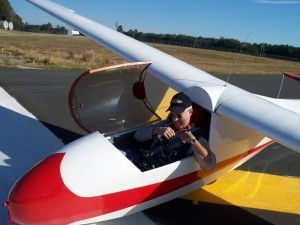 [Editor’s Note: This article was written by Marty Flournoy from Columbus, GA for the EAA Chapter 677 Newsletter. Marty is a commercial glider pilot and member of Rose City Soaring Association, LLC.]
[Editor’s Note: This article was written by Marty Flournoy from Columbus, GA for the EAA Chapter 677 Newsletter. Marty is a commercial glider pilot and member of Rose City Soaring Association, LLC.]
Several members of the club have acquired a vintage German Schleicher Ka8 Sailplane that was due to be christened Saturday by the club members. With the temperatures being slightly colder than ideal, we were not expecting much if any lift to help us stay aloft after being towed up. Because it is a single place design, there is no dual instruction to be checked out, only a good detailed briefing by another pilot who has flown the same type glider. Sporting high aspect ratio long wooden wings that span over 50 feet, connected to a fuselage built of trussed 4130 steel tubing, covered in Dacron fabric, the Ka-8 is definitely a classic design with a vintage look.
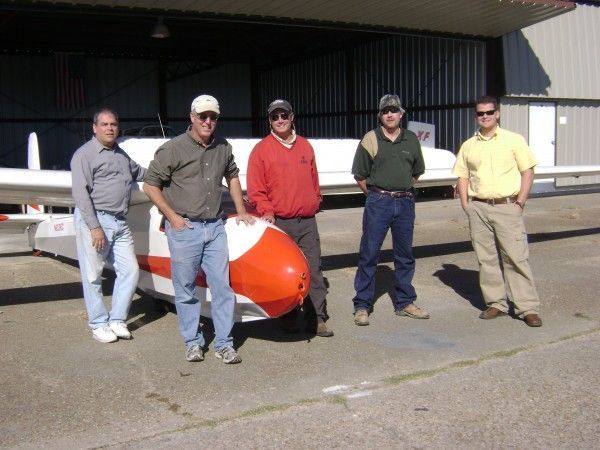
Several of the club members after the first assembly. From left to right: Frank Flowers, Lane Bush, Marty Flournoy, David Hill and Tony Cooper
After being checked out by Lane Bush on how the controls were configured and the spoiler use, I carefully slid into the very comfortable reclined single seat and buckled up the German version of a four-point harness.
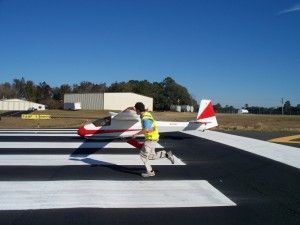 As the ground crew connected the tow rope and signaled for the tow plane to take up slack, I was cautiously hoping that I would be able to get started down the runway without scraping a wing or getting into a P.I.O. rock and roll, as Lane had cautioned me about. With ball bearing push rod controls, the much more sensitive elevator and roll rate of the Ka-8, compared to the very dampened and slower Schweizer 2-33 that we have been flying, was going to be quicker in several ways. The wing runner looked at me, and when the tow line became taught I signaled I was ready with a thumbs up and a waggle of my rudder. The tow plane responded with an acknowledging rudder waggle. The Cessna 182 responded immediately with a strong tug on the poly tow rope and we started rolling with much faster acceleration than the 2-33 I had been used to.
As the ground crew connected the tow rope and signaled for the tow plane to take up slack, I was cautiously hoping that I would be able to get started down the runway without scraping a wing or getting into a P.I.O. rock and roll, as Lane had cautioned me about. With ball bearing push rod controls, the much more sensitive elevator and roll rate of the Ka-8, compared to the very dampened and slower Schweizer 2-33 that we have been flying, was going to be quicker in several ways. The wing runner looked at me, and when the tow line became taught I signaled I was ready with a thumbs up and a waggle of my rudder. The tow plane responded with an acknowledging rudder waggle. The Cessna 182 responded immediately with a strong tug on the poly tow rope and we started rolling with much faster acceleration than the 2-33 I had been used to.
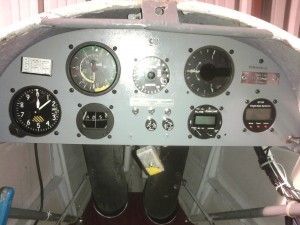 With a headwind of almost 10 knots it seemed like the Ka8 became airborne in less than five seconds and started climbing quickly. My automatic reaction was to push the stick forward with brisk authority. The Ka-8 responded much faster than I was prepared for and I pulled back slightly, which made the flight path of the glider resemble a porpoise for a few brief seconds that seemed more like minutes as I settled down with my elbow firmly planted at my right leg to limit any further control movements to my wrist only. At this point I was now under the spell of the timeless German design and engineering that allowed the Ka8 to follow the 182 with just minor inputs to the stick and rudder. The previously laborious job of following the tow plane to altitude in the lumbering two-seater was now like a video game where you were following an enemy aircraft hoping to close in for the final kill. As we made some large circuits north of Quitman field in the direction of the prevailing wind, I noticed a few places where we were getting some mild thermal lift, which surprised me.
With a headwind of almost 10 knots it seemed like the Ka8 became airborne in less than five seconds and started climbing quickly. My automatic reaction was to push the stick forward with brisk authority. The Ka-8 responded much faster than I was prepared for and I pulled back slightly, which made the flight path of the glider resemble a porpoise for a few brief seconds that seemed more like minutes as I settled down with my elbow firmly planted at my right leg to limit any further control movements to my wrist only. At this point I was now under the spell of the timeless German design and engineering that allowed the Ka8 to follow the 182 with just minor inputs to the stick and rudder. The previously laborious job of following the tow plane to altitude in the lumbering two-seater was now like a video game where you were following an enemy aircraft hoping to close in for the final kill. As we made some large circuits north of Quitman field in the direction of the prevailing wind, I noticed a few places where we were getting some mild thermal lift, which surprised me.
As we approached the 3,000 feet agl release point, I was already planning to return to the location of the turbulent air as some lift was indicated by the presence of circling turkey vultures riding an upward current. As I made my way over to the plowed field, I could hear the variometer making a faint blip, indicating what promised to be more lift just ahead. At about the time I passed over the circling birds, I was in a descent at about 150 ft/min. I felt my hopes for some free lift diminishing until spring brought warmer weather all of a sudden, and the variometer started going off indicating the thermal the birds were using to stay aloft. I made a quick look to the left to see if anyone or anything had overtaken me at my 6 o’clock. Seeing that it was clear, I made an abrupt left turn into a 360 to try and stay in the core of the rising air.
Almost 30 minutes had passed before I realized other pilots on the ground might want to fly, so I initiated a series of chandelles and stalls to check out the flight characteristics of our new soaring machine. The stall and flight maneuvers are very predictable and very easy to recover from. I could easily see why so many instructors prefer to have power students learn the basics in a glider before moving on to power.
As the altimeter wound its way down to 1,000 ft, albeit rather slowly, I announced my intentions over the handheld radio and entered left traffic with the dive brakes/spoilers fully deployed. The Ka-8 has almost no pitch change as the airbrake is extended, which allows the pilot to concentrate on glide angle and airspeed without any adjustments of stick forces or trimming that is normally associated with flaps. We had decided that the grass area on the north side of runway 28 would be the ideal place to recover the glider for tow back to the start area, so I entered just a slight slip to increase glide angle while staying close to the field. The Ka-8 felt as if we were flying in slow motion, almost like I was flying a simulator in the beginner mode. As we passed the runway threshold, a slight motion of my wrist brought the nose up and let the single wheel under the pilot seat touch down with a very mild bump. The headwind of 10 knots made the ground roll like that of an ultralight, taking less than 100 feet with the nose skid stopping the ship as soon as it touched the turf. Brice, our eager wing runner, was there in just seconds to assist me in backing the Ka-8 to the extended threshold at the approach end of runway 28 to be ready for the next tow by the C182.
It was less than 10 minutes before the 2-33 released and the 182 was back on the runway ready to tow. Everyone wanted to fly the two place 2-33 in order to log instruction flights with Lane, so I hooked up the Ka-8 and took a second flight. This time, as the line came taut, I rested my right arm on my leg and only used my wrist to move the stick. In an instant we were airborne and this time it was effortless to play follow the leader up to release altitude.
Having seen all the vultures and raptors circle for the last couple of hours, it was now easier to pin point where the afternoon lift was occurring. I released and made my way over to a pasture just beyond the highway leading into Quitman and–BINGO–the Ka-8 bounced as I went through the rising current of air, just then the variometer squealed as if it were telling me, ”turn now, turn around now” so as to not miss the free ride up. With the turn started, the noise subsided and settled down to a rapid clicking noise, indicating just a mild amount of lift–barely enough to stay aloft at 2.800 feet where I had initially entered the thermal. As I came around the second turn, the variometer was telling me I had moved out of the lift so I turned back to the west and tried to capture the lift again, this time only getting a slight blip and then sinking air.
Like a game of blind man’s bluff, I searched around for the circling buzzards and caught sight of two that had moved slightly downwind and still to the north of the approach end of runway 28. With so little time in the Ka-8, I did not want to get too far from the field, especially downwind, as it this lightly loaded medium performance ship doesn’t penetrate well into a headwind.
I descended making s-turns and feeling for some thermals. I was finally able to scavenge some lift as I was close to our 1,500’agl limiting altitude for thermaling near the airport. Soon I was holding my own and actually squeaked out almost 150-200 fpm lift for several 360’s.
Finally, the lift left me and I set up for the landing which was now something I was curious about, to see if I could get another good spot landing without a big drop. The Ka-8 came around on final with spoilers fully deployed and I was still amazed at how easy it was to control the sink rate and speed to make the touchdown a non-event.
After we got the Ka-8 over to the transport trailer and started taking the wings off, it occurred to me that this sailplane had seen a lot of flights in its 40 plus year history and had probably given many pilots a lot of entertaining flights just as I had experienced. Looking at my watch, I realized I had been airborne almost an hour with almost no lift to be found and had enjoyed an amazing afternoon.
You can bet I am looking forward to this spring when the thermals make longer flights possible and the opportunity to do some cross country flights with other club members as we learn all we can about soaring, what seems to me to be the ultimate challenge in learning to fly. I hope many of you will check out the doors soaring can open up in aviation.

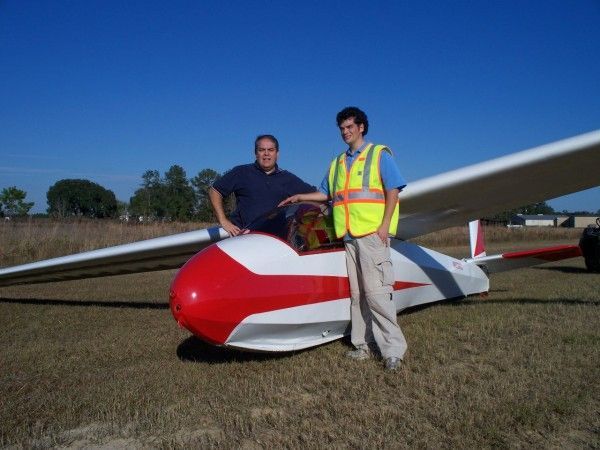
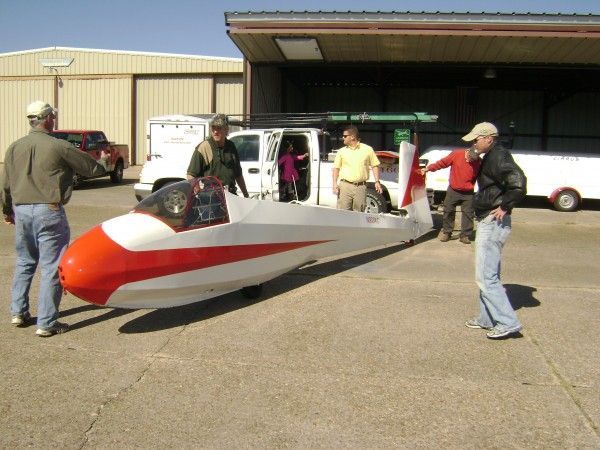






1 comment for “The Christening of our Ka-8”